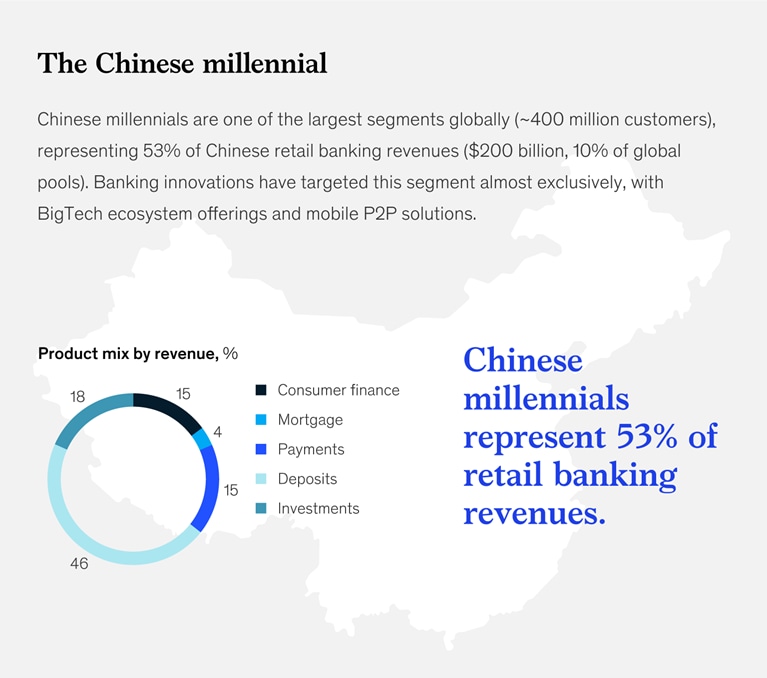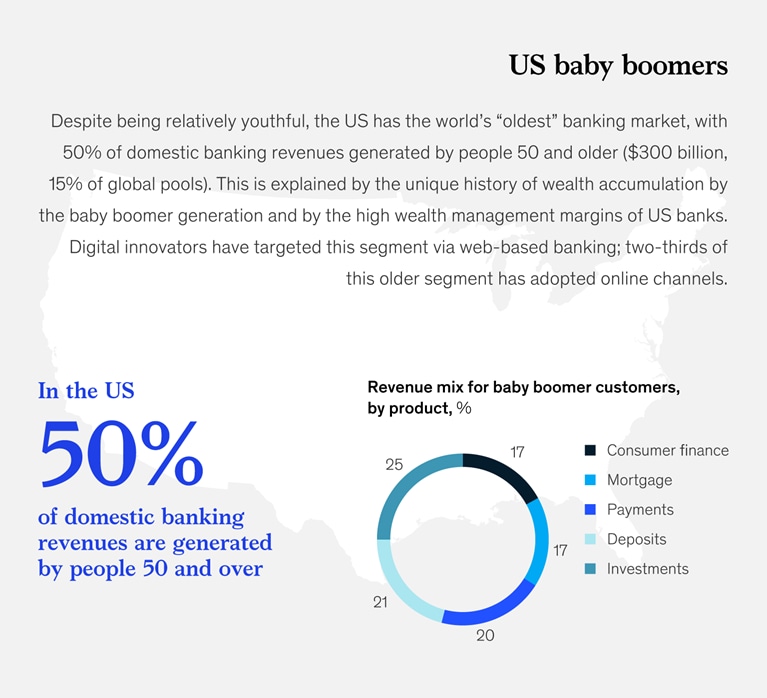In this piece, based on detailed research from McKinsey Panorama that was begun prior to the crisis, we look at how retail banking revenues related to customers of different generations vary across the world.
1. Retail banks in emerging markets derive more revenue from younger customers; the opposite is true in developed markets.
The varying behaviors of older and younger generations shape all economic sectors continuously, including the banking industry. In general, retail banking revenue splits by generation (e.g., Gen X, baby boomers1) differ across emerging and developed markets. In the former, almost half of retail banking revenues are generated by people under 35; in the latter, almost half comes from people 50 or over. This difference has large implications for banking product and channel innovation, as clients have different needs and financial behaviors in these two types of markets.

2. Typically, generations X and Y account for the largest share of banking revenues.
Globally, the prime age of banking clients (calculated as the revenue-weighted median age) ranges from 30 (Vietnam, South Africa) to 50 (US, Italy)—a variance partly explained by demographics. However, country-level patterns matter. Banking revenues in “aging” countries such as China, Mexico, or Vietnam come largely from younger customers, while in “younger” countries such as the United Kingdom, a disproportionate share of banking revenues come from older customers. A country’s history of wealth accumulation, regulation, and financial innovation plays a large role in determining the share of banking revenues that come from different any particular generation.



3. Financial inclusion is a global opportunity across all age groups.
Financial inclusion for all generations is an opportunity in emerging markets, especially in the BRIC economies and other large-scale markets with low banking penetration rates such as Mexico, Indonesia, Nigeria, and Morocco. Gens Y and Z are especially high-potential segments for banks to consider, as this age group represents the longest customer lifecycle.
Even more important, irrespective of a country’s economic development, about a quarter of customers worldwide are underbanked. That is, they have a basic bank account for transactions, but don’t use any lending or savings products. New digital value propositions (such as mobile POS loans, microfinance, P2P lending/investing, and personal financial management products) can meet this demand, which has been boosted as a result of COVID-19-related lockdowns. Many banks are looking to increase their digital offerings for clients while also running education programs to spur further uptake and usage.

4. The “mobile first” segment is reaching an inflection point, led by the young.
Globally, more than two-thirds of Generations Y and Z are using digital channels (online or mobile). While only a minority of baby boomers have traditionally used such channels, we expect a significant change in this share due to the COVID-19 crisis. Among digital channels, we expect mobile banking applications to reach an inflection point as a result of customers having to bank remotely. In the US and in emerging markets such as China or Russia, mobile will soon become the first choice for banking, whether for payments or more complex financial products. Europe and Japan lag in mobile banking, due to the earlier arrival of web-based digital channels, which have become entrenched.

5. By looking at age and income levels, banks can discover previously hidden customer needs.
Of course, age and generational differences represent only one perspective on retail banking client needs. When combined with income or wealth patterns, the insights and strategic implications for banks become richer. For example, many banks focus on high-income but not-yet-rich customers (HENRYs) as a target segment, instead of trying to meet the diverse needs of all Gen Z or Gen Y customers. Others focus on pre-retiree affluent customers or on products and services for the mass market. As Exhibit 5 illustrates, banks have an enormous opportunity to provide innovative and technology-enabled financial services to customers across all generations. Banks should also consider how COVID-19’s impact on post-risk revenues will differ by segment—we expect younger, lower-income customers to be impacted more than older and higher-income customers, especially in markets like the US where certain segments have low financial resilience (low savings ratio, high debt burden).

About us
Panorama Financial Institutions and Insights Consulting (PFIC) is McKinsey’s banking and insurance capability center. PFIC is a key driver of financial expertise, capabilities and insights, including the development of more than 15 proprietary knowledge assets.


